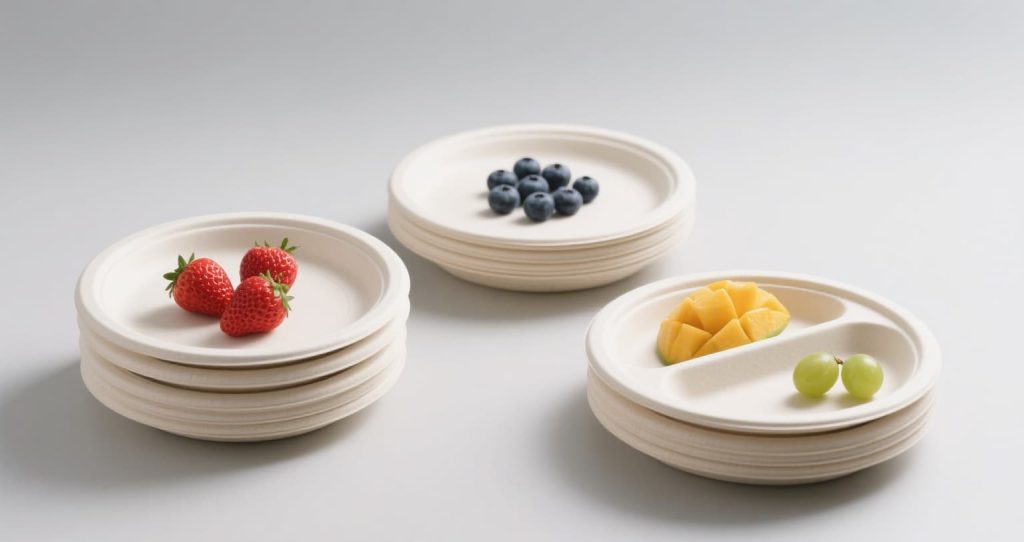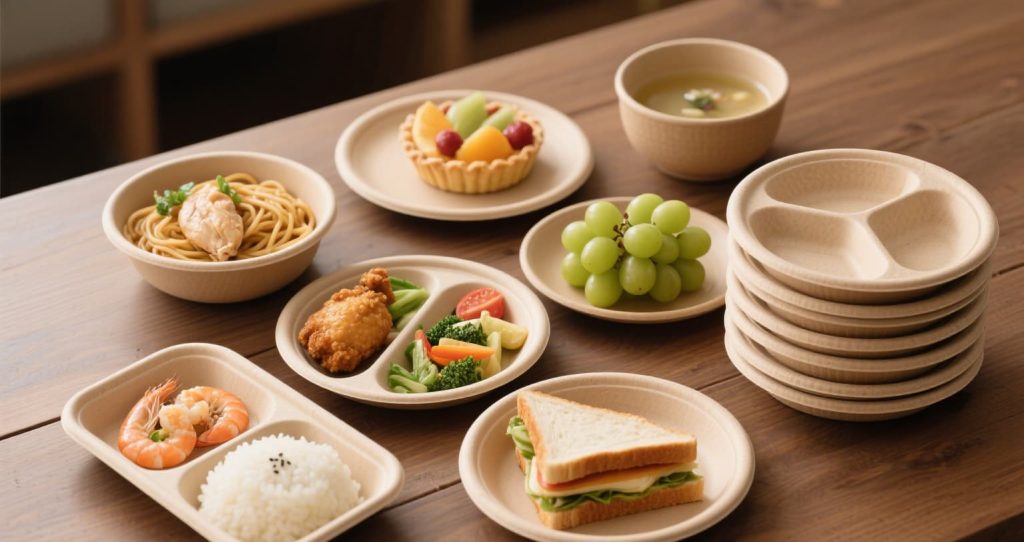In an era where sustainability is no longer a choice but a necessity, Sugarcane Bagasse Trays are emerging as a leading solution in the food packaging industry. Made from the fibrous residue left after extracting juice from sugarcane, these trays offer a biodegradable, compostable, and cost-effective alternative to traditional plastic and foam containers.

✅ What is a Sugarcane Bagasse Tray?
Bagasse is a byproduct of sugarcane processing—typically discarded or burned. However, with advances in green manufacturing, this natural fiber is now being molded into sturdy, food-safe trays suitable for a wide range of foodservice applications.
A Sugarcane Bagasse Tray is:
- 🍃 100% biodegradable and compostable
- 🍽️ Safe for direct food contact
- 🔥 Heat-resistant up to 120°C
- ❄️ Freezer- and microwave-safe
- ♻️ Renewable and made from agricultural waste

🌍 Environmental Benefits
Compared to conventional plastic or Styrofoam trays, bagasse trays have a much lower carbon footprint. Here’s how they help the planet:
- Zero Waste: Made from agricultural waste that would otherwise be discarded.
- Carbon Neutrality: No fossil fuel-based ingredients.
- No Harmful Toxins: Free from petroleum, bleach, and heavy metals.
- Compostable: Degrades naturally within 60–90 days in industrial composting conditions.
♻️ Fact: According to the UN Environment Programme, nearly 36% of plastic production is used in packaging, and a large portion is single-use. Sugarcane bagasse trays offer a meaningful alternative.
🍱 Applications in the Food Industry
Sugarcane bagasse trays are used across various food segments, including:
- Quick-service restaurants (QSRs) 🍔
- Airline catering 🍱
- Takeout and delivery 🛵
- Cafeterias and school lunches 🍛
- Food courts and malls 🍗
- Eco-conscious event catering 🥗
From salads and pasta to grilled meals and desserts, these trays are available in various shapes and compartments to suit every culinary need.

🔬 Performance Comparison: Bagasse vs. Plastic Trays
| Feature | Sugarcane Bagasse Tray | Plastic Tray |
|---|---|---|
| Material | Natural fiber | Petroleum-based |
| Biodegradable | ✅ Yes | ❌ No |
| Microwave Safe | ✅ Yes | ⚠️ Often not |
| Compostable | ✅ Yes | ❌ No |
| Heat Resistance | ✅ High (up to 120°C) | ⚠️ Limited |
| Sustainability | ✅ Renewable | ❌ Non-renewable |
🌐 Why Businesses Are Making the Switch
With governments around the world tightening restrictions on single-use plastics, companies are actively seeking eco-friendly packaging options. Bagasse trays align with:
- 🌿 ESG goals
- 📦 Green supply chains
- ✅ Compostable packaging certifications (like EN 13432, ASTM D6400)
At Xiamen Dashan, we offer customizable sugarcane bagasse trays that meet global food safety and compostability standards. Our trays are exported worldwide to clients who demand high performance without compromising on sustainability.
💡 Industry Trends
- EU & US plastic bans: Retailers and foodservice providers are mandated to reduce plastic packaging.
- Compostable packaging demand: Expected to grow at a CAGR of 14.3% through 2030 (source: Grand View Research).
- Zero-waste restaurants: Bagasse trays are becoming part of zero-waste dining experiences.
🙋 Frequently Asked Questions (FAQ)
Q1: Are sugarcane bagasse trays safe for hot foods?
A: Yes, they can withstand temperatures up to 120°C and are microwave- and oven-safe.
Q2: How long does it take for a bagasse tray to decompose?
A: In industrial composting, decomposition typically occurs in 60–90 days.
Q3: Are bagasse trays waterproof?
A: Yes, they can hold moist and greasy foods without leaking.
Q4: Can I print my brand on a bagasse tray?
A: Custom embossing and packaging solutions are available. At Dashan, we offer flexible branding options.
🔚 Conclusion
Sugarcane Bagasse Trays represent the future of sustainable food packaging. They are not just an eco-conscious choice, but also a practical one—offering strength, heat resistance, and versatility. For food businesses seeking to reduce their environmental impact without compromising on quality, switching to bagasse trays is a step in the right direction.
📚 References
- UN Environment Programme: www.unep.org
- Grand View Research – Compostable Packaging Market: www.grandviewresearch.com
- European Commission – Single-Use Plastics Directive: ec.europa.eu
- ASTM International – D6400 Standard: www.astm.org
